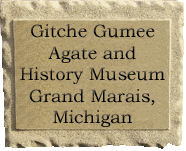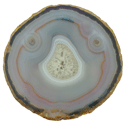MINERAL OF THE MONTH
January 2012 - Mary Ellen Jasper

The mineral of the month for this update is Mary Ellen Jasper. Unless you live in Minnesota, you may not be familiar with this interesting form of microcrystalline quartz. This rock formed more than two billion years ago in the area that is now the Mesabi Iron Range in Northern, Minnesota. At that time one of the early life forms evolved in the ancient seas. These blue-green single-celled cyanobacteria contained chlorophyll and were able to harvest the energy of the sun to photosynthesize and produce their own food. Energy from sunlight was used to split carbon dioxide into carbon and oxygen. The carbon was absorbed, becoming part of the growing organism, and the oxygen was released into the atmosphere. Prior to the evolution of cyanobacteria, there was almost no oxygen in the atmosphere. Once these organisms developed, they proliferated and helped to trigger drastic changes in the earth's atmosphere, climate, and environment.
Some of the cyanobacteria lived in colonies that produced macro-scale structures called stromatolites. A drawing depicting what a stromatolite shoreline may have looked like during the latter part of the Archean period is shown below. Evidence of fossil stromatolite formations have been found throughout the world so these mushroom-shaped mounds dominated the shores of all the newly developing landmasses, including the area where the Mary Ellen Jasper developed.

The earliest stromatolite of confirmed origin dates to 2,724 million years ago. A recent discovery, however, provides strong evidence that microbial stromatolites extending as far back as 3,450 million years ago. These organisms were extremely resilient and adaptable, allowing them to be a major constituent of the fossil record for the first 3,500 million years of life on earth, with their abundance peaking about 1,250 million years ago.
Until the mid-1950s, scientists thought that stromatolites were long since extinct. That all changed in 1956 when living stromatolites were found in the Hamlin Pool located on the south end of Sharks Bay in Western Australia. Since then, live stromatolites have also been found in several sites in the Bahamas. Pictures of both are included below.
Stromatolites are stony structures built up by algae and cyanobacteria. The microbes live in gooey mats on the top surface of the structures. These mats trap fine sediments carried across them by tidal currents. As the mats fill in with sediments and become opaque, the microbes move upwards seeking sunlight. Stromatolites differ from normal fossils because they are formed by the activities of micro-organisms. They result from a combination of trapping, binding and precipitation of sediment.
One of the biggest impacts that stromatolites had on the earth was the release of free oxygen, which was a byproduct of their photosynthesis. When stromatolites first evolved, the earth's atmosphere had less than one percent oxygen. After the stromatolites evolved, significant amounts of oxygen did not accumulate in the atmosphere right away because of the vast quantities of oxidizable materials in the earth's crust as well as the dissolved eager-to-combine iron in the oceans. For more than a hundred million years, these materials absorbed any free oxygen that was produced. Mary Ellen Jasper developed not only from the remains of the stromatolites, but also from the oxidization of iron that was present in the area that is now northern Minnesota.
A few more pictures of Mary Ellen Jasper are included below. The first two pictures are of a thin polished slab. The first is displayed with front lighting and the second with back lighting.
Coincidently, I just polished a piece of Mary Ellen Jasper for a customer a couple of days ago. Here is a picture of that specimen.
Mineral of the Month Archives
May 2007: Rainbow Fluorite
June 2007: Lake Superior Michipicoten Agate
July 2007: Labadorite
August 2007: Rain Flower Agate
Fall 2007: Malachite
December 2007: Nepheline Syenite
January 2008: Native Copper
February 2008: Amazonite
March 2008: Lake Superior Agate
April 2008: Shadow Agate
May 2008: Apohpylite
June 2008: Ocean Jasper
Summer 2008: Marra Mamba Tiger's Eye
September 2008: Mohawkite
October 2008: Mexican opal
November 2008: Prehnite
December 2008: Picture Jasper
January 2009: Sea Shell Jasper
February 2009: Polychrome Jasper
March 2009: Selenite Desert Rose
Spring 2009: Coyamito Agate
July 2009: Obsidian Needles
August 2009: Goethite
September 2009: Banded Iron Formation
Fall 2009: Fairburn Agate
March 2010: Fossilized Dinosaur Bone
April/May: 2010 Kentucky Agate
June 2010: Nantan Meteorite
July 2010: Mookaite Jasper
Aug/Sept 2010: Polyhedroid Agate
Fall 2010: Ammonite Fossil
September 2011: Petoskey Stones
Spring 2011: Petrfied Wood
Winter 2011: Argentina Condor Agate
January 2012: Mary Ellen Jasper
March 2012: Mexican Crazy Lace Agate
June 2012: Moqui Marbles
September 2012: Chlorastrolite Greenstone
March 2013: Jacobsville Sandstone
August 2013: Unakite
November 2013: Skip-an-Atom Agate
April 2014: Tiger's Eye
September 2014: Black Corundum
February 2015: Condor Agate
June 2015: Petoskey Stone
November 2015: Slag
June 2016: Lake Superior Copper Replacement Agates
March 2017: Chert
July 2017: Kona Dolomite
December 2017: Septarian Nodule
Copyright All rights reserved.
Gitche Gumee Museum.
E21739 Brazel Street
Grand Marais, Michigan 49839










